If you’re a cyclist, you’ve probably heard of quick-release and through axle. Both are used to secure the wheels of a bike to the frame, but they differ in design and function. Quick release is a traditional system that has been used for decades, while through axle is a newer technology that has gained popularity in recent years.
Quick release is a system that uses a skewer to secure the wheel to the frame. The skewer is a thin rod that passes through the center of the wheel hub and is held in place by a lever on one end and an adjusting nut on the other. To remove the wheel, you simply open the lever and unscrew the nut, allowing the skewer to slide out.
Quick release is a lightweight and convenient system that allows for quick and easy wheel changes, making it popular among road cyclists and commuters. However, it is not as secure as through axle and is not recommended for use in high-stress situations such as mountain biking or cyclocross racing.
Fundamentals of Bike Axles
Bike axles are a crucial component of any bicycle. They connect the wheel to the frame or fork and ensure that the wheel spins smoothly and securely. There are two main types of bike axles: quick-release and through axle.
Definition of Quick Release
A quick-release axle is a type of bike axle that uses a skewer with a camming mechanism to hold the wheel in place. The skewer is inserted through the hollow axle and tightened by turning a lever. This mechanism allows for easy removal and installation of the wheel without the need for tools.
Quick-release axles are commonly found on road bikes, hybrid bikes, and some mountain bikes.

Definition of Through Axle
A through axle, also known as a bolt-on axle, is a type of bike axle that uses a threaded rod to secure the wheel to the frame or fork. The axle is inserted through the hub and frame or fork, and then secured with a nut or lever. Through axles are commonly found on mountain bikes, cyclocross bikes, and some road bikes.

One of the main differences between quick release and through axle is their level of security. Through axles provide a more secure connection between the wheel and the frame or fork, which is especially important for off-road riding. Quick-release axles, on the other hand, are more convenient for quick wheel changes and are generally lighter.
Another difference is the compatibility with different frame and fork types. Quick release axles are compatible with most frames and forks, while through axles require a specific frame and fork design. Additionally, through axles are available in different lengths and diameters to fit different frame and fork configurations.
In summary, both quick release and through axle have their advantages and disadvantages. The choice between them depends on the type of riding you do and your personal preferences.
Mechanical Differences
When it comes to mechanical differences, there are a few key areas where quick release and through axle differ. These include axle diameter, axle length, and attachment mechanism.
Axle Diameter
Quick-release axles typically have a diameter of 5mm, while through axles have a diameter of 12mm or 15mm. This difference in diameter affects the stiffness and strength of the axle.
The larger diameter of the through axle provides more rigidity and stability to the wheel, making it less likely to flex or move out of place during use. This can be especially important for off-road riding or other high-stress situations.
Axle Length
Another key difference between quick release and through axle is the length of the axle itself. Quick release axles are typically shorter than through axles, with a length of around 100mm for the front and 130mm for the rear.
In contrast, through axles are longer, with a length of around 110-120mm for the front and 142-148mm for the rear. This increased length provides more support and stability to the wheel, reducing the risk of flex or movement.
Attachment Mechanism
The attachment mechanism for quick release and through axle is also different. Quick-release axles use a lever-based system, where the rider simply flips a lever to release or tighten the axle. This can be quick and convenient, but it also means that the axle can be less secure and more prone to movement or flexing.
In contrast, through axles use a threaded system, where the axle is screwed into the frame or fork. This provides a more secure and stable attachment, but it can also be more time-consuming and difficult to use.
Performance Implications
Stiffness and Stability
When it comes to stiffness and stability, through axles are the clear winner. They provide a more secure attachment of the wheel to the frame, which reduces flex and improves handling. This is especially important in high-stress situations like mountain biking or during hard cornering.
On the other hand, quick release axles can be less stiff than through axles. This can impact wheel rigidity and stability, which can be a concern in high-stress situations. However, quick release axles are still widely used and can be perfectly adequate for casual riding or road cycling.
Wheel Alignment Accuracy
Through axles also provide better wheel alignment accuracy. This is because they use a fixed axle that is threaded directly into the frame. This ensures that the wheel is always aligned perfectly, which can improve handling and reduce wear on the bike components.
Quick-release axles, on the other hand, use a tensioning system that can allow for slight misalignment of the wheel. This can result in poor handling and increased wear on the bike components over time.
Compatibility and Interchangeability
When it comes to compatibility and interchangeability, there are some important differences between quick release and thru-axle systems to consider.
Frame and Fork Requirements
One of the most significant differences between quick-release and thru-axle systems is the frame and fork requirements. Quick-release systems use dropouts that are open on both sides, while thru-axle systems use a closed dropout on one side and a threaded insert on the other. This means that you cannot use a quick release wheel on a thru-axle frame or fork, and vice versa.
It is important to note that some frames and forks are designed to be compatible with both quick release and thru-axle systems. However, it is essential to check the specifications of your frame and fork before making any changes to your wheel system.
Wheel Compatibility
Another factor to consider when it comes to compatibility and interchangeability is wheel compatibility. Quick-release wheels are generally more widely available and can fit a broader range of bikes. Thru-axle wheels, on the other hand, are typically found on high-end bikes and are less common.
If you are looking to upgrade your wheel system, it is important to ensure that your new wheels are compatible with your frame and fork. If you are unsure, it is always best to consult with a bike mechanic or refer to the manufacturer’s specifications.
Pros and Cons
Quick Release Advantages
Quick-release axles are the better choice for casual cyclists, those on a budget, those who frequently remove their wheels, bikes with rim brakes, those who value lighter weight, and those who are seeking compatibility with existing gear.
The primary advantage of quick-release axles is the ease of use. They can be removed and installed quickly without the need for tools. This makes it easier to transport your bike and fix a flat tire on the go. Quick-release axles also tend to be lighter than thru axles, which can be important for weight-conscious cyclists.
Through Axle Advantages
On the other hand, thru axles are the preferred choice for serious cyclists, especially those who ride off-road. Thru axles provide a stiffer and more secure connection between the wheel and the frame, which can improve handling and stability on rough terrain.
Thru axles also tend to be more durable than quick-release axles and less likely to come loose during a ride. Additionally, thru axles can accommodate wider hub spacing, which is important for disc brakes and larger tires.
Considerations for Cyclists
When choosing between quick release and thru axle, there are a few things to consider. First, make sure that your frame and fork are compatible with the type of axle you want to use. Thru axles require a different dropout design than quick release axles, so you may need to purchase a new frame or fork if you want to switch.
Second, consider your riding style and the types of terrain you’ll be riding on. If you’re a casual cyclist who sticks to smooth pavement, quick-release axles may be sufficient.
But if you’re a serious cyclist who tackles rough terrain, thru axles may be the better choice. Finally, consider your budget. Thru axles tend to be more expensive than quick-release axles, so make sure you’re willing to invest in the higher cost if you choose to go that route.
Frequently Asked Questions
How can I convert my quick release to a thru axle?
Converting a quick-release system to a thru axle system is not a simple process. It requires changing the fork or frame of the bike, which can be expensive and time-consuming. It is recommended that you consult with a professional bike mechanic before attempting to convert your bike to a thru axle system.
How do I determine if my bike uses a quick-release or a thru axle system?
To determine if your bike uses a quick release or a thru axle system, look at the front and rear axles. Quick-release systems use a lever to secure the wheel to the frame, while thru axle systems use a threaded axle that is inserted through the hub and frame.
Thru axles are typically found on higher-end bikes, while quick-release systems are more common on entry-level and mid-range bikes.
What are the common sizes for thru axles on road bikes?
Thru axles come in a variety of sizes, depending on the type of bike and the manufacturer. Common sizes for road bikes include 12mm x 100mm for the front axle and 12mm x 142mm for the rear axle. However, it is important to check the manufacturer’s specifications for your specific bike to ensure that you purchase the correct size.
What tools are required for installing or removing a thru axle?
Installing or removing a thru axle requires a specific set of tools. You will need a 5mm or 6mm hex wrench to remove the axle from the frame or fork, and a torque wrench to ensure that the axle is tightened to the manufacturer’s specifications. Some thru axles also require a special tool to remove the threaded end cap, so be sure to check the manufacturer’s specifications before attempting to remove the axle.
